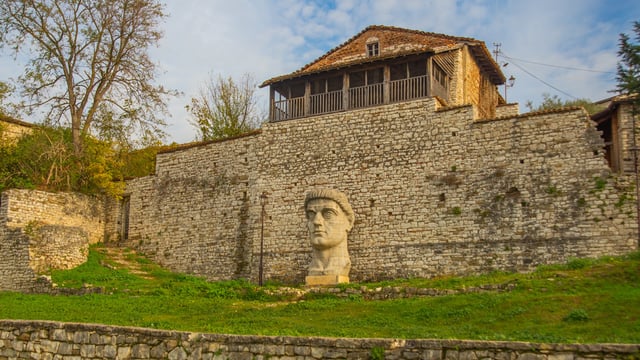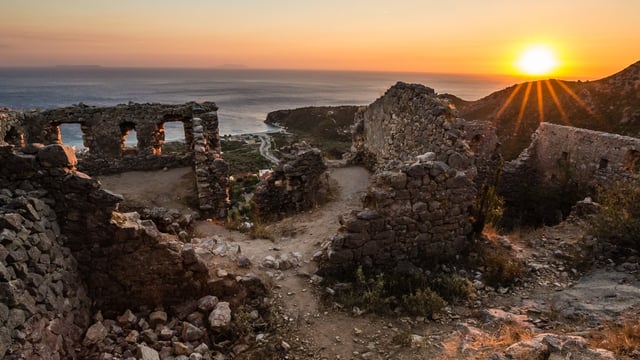Albania Travel Guide
Reasons to Visit Albania




… and Dramatic Landscapes.
About Our Albania Travel Guide
Whether you want to visit a few highlights of Albania’s heritage or are planning a more extensive trip, you are sure to find what you need here. From recommendations for the best sites and museums to visit to more extensive thematic lists. From suggested itineraries to tools to create your own itinerary and travel lists. As well as many other resources, travel tips and ideas. This guide focuses on the art, archaeology and history of Albania through the various sites, landmarks and museums open to the public. It is produced and maintained by Thomas Dowson, the founder of Archaeology Travel. Read more about the authors and how we create these guides, as well as our mission and vision. The page was last checked and/or updated on 15 October 2023.
Interesting Things to Know About Albania
Albania has four sites on the UNESCO list of world heritage sites. Two of these are cultural (the archaeological site of Butrint and the two historic towns of Berat and Gjirokastra) and one natural, the ancient beech forests of Europe. The fourth is mixed, the Ohrid region, which is noted for both cultural and natural aspects. A further four historic attractions are on UNESCO’s tentative list. These are the Royal Illyrian tombs near Pogradec, the Roman amphitheatre in Durres, the ancient city of Apollonia and Bashtova Castle. Albanian iso-polyphony, traditional folk singing in two, three or four parts, is included on the UNESCO intangible cultural heritage list. UNESCO Sites in Albania.
Explore Albania
Archaeology & History Sites in Albania
Archaeological Ruins of Synagogue & Basilica
In the historic centre of Saranda are the exposed remains of religious buildings from the ancient town of Onhezmus. What started out as a Christian basilica in the 4th century AD was converted into a Synagogue towards the end of the 5th century to serve the local Jewish community. Sometime later the synagogue was converted into a Christian church. On view are some of the exceptional mosaics that were uncovered, some of which have obvious Jewish symbols such as the menorah.

Ardenica Monastery
Officially known of as the Monastery of the Nativity of the Theotokos in Ardenica, the monastery is not set up for visitors. For a donation, however, there is usually a custodian present who will show you around. Guided tours from major cities in Albania are possible. Thought to have been built in 1282 for the Byzantine Emperor, Andronikos II Palaiologos, following his victory at the Siege of Berat. The monastery has some very well preserved frescoes and gold and polychrome icons made during the 18th century.

Church of the Amphitheatre
Soon after the amphitheatre in Durrës stopped being used for spectacles, a small chapel was constructed on the edge of the arena. Probably because the structure became a site of religious practices as well as a graveyard. This is thought to have been sometime in the 5th or 6th century AD. Initially the chapel was decorated with frescoes, but a century or two later mosaics were added. These depict various saints, including Saint Stephen, the martyr of the city of Durrës.

Gjirokastra Cold War Tunnel
Near the present-day municipal offices of Gjorokastra is the entrance to an underground bunker. The municipal offices were the headquarters of the local Communist Party, and the bunker the emergency facility in case of nuclear attack. Built in the 1970s, the bunker is 800 m long with 59 rooms. Although a lot of furniture was looted in 1990, several pieces from the period remain. Otherwise the bunker has been left in its original state. A tour of the Cold War Tunnels takes about 20 minutes.

Kapllan Pasha Tomb
Built in 1820 this octagonal tomb was built for Kapllan Pasha, the Ottoman administrator of Tirana, who died in 1819. His remains were subsequently repatriated to Istanbul. The tomb was built next to the Sylejman Pasha Mosque and the Suleyman Pasha Tomb – both of which were destroyed during World War II. Although also ruined in November 1944, the Kapllan Pasha Tomb was restored and in 1948 was declared a Cultural Monument of Albania.

Roman Sites & Museums in Albania
Ancient Butrint - Buthrotum
Although the area around the archaeological site of Butrint has evidence of prehistoric occupation, it is better known as an ancient Greek city, a Roman colony and an early Medieval Bishopric. The ancient city is on a hill that overlooks the Vivari Channel and now in the Butrint National Park. Looters and poor conservation measures meant the site was in considerable danger, but the joint work of heritage and funding institutions turned the situation around for one of Albania’s important heritage sites.

Apollonia Archaeological Park
Apollonia was established by Greek colonists from Corfu and Corinth, and developed into one of the most important ancient Greek cities in Illyria. The city flourished during the Roman period, but was abandoned by late antiquity. An onsite museum has some of the finest artefacts from the site on display, including a spectacular mosaic floor, various frescoes and artefacts from prehistory to the Roman period. Guided tours of the Apollonia Archaeological Park are available, but visits without a guide are also possible.

Durrës Roman Amphitheatre
At 136 m by 113 m and seating an estimated 20,000 spectators, the Roman amphitheatre in Durrës is the largest on the Balkans peninsular. It was built in the second century BC during the reign of Emperor Trajan, and was still in use up until the 4th or 5th century AD. About a third of the structure was uncovered in the late 1960s, while the rest not until the 1980s. Preserved inside the ruins of the arena are the remains of a small chapel that is dedicated to the first bishop of Durrës Saint Astius.

Castles in Albania
Ali Pasha Castle
Near the archaeological site Butrint in the bay of Porto Palermo. Hence why it is also known as Porto Palermo Castle. This relatively well preserved castle was initially built by the Venetians in the 15th century. In 1804 the castle was seized by Ali Pasha of Tepelena, a powerful ruler of this region of Albania in the early 19th century. Until 1820, the castle was the Pasha’s second residence. It is a relatively small fort compare to his other forts, probably built to control access to Butrint.

Berat Castle
The earliest dates for building on the hill above Berat are from the 4th century BC. The hilltop has been successively occupied by the Illyrians, Greeks and Romans up to the Ottomans and the present. With a perimeter of 1400 m, the castle encloses 10 hectares with 300 inhabitants still living here today. Besides some of the finest preserved 17th century Ottoman houses, there are 12 churches, the ruins of two mosques and the 18th century Dormition of St Mary, don’t miss the Onufri National Iconographic Museum

Castle of Gjirokastra
Overlooking an important route through the valley below, the citadel has been in use since at least the 12th century. The Ottomans extended the fortress substantially. And in the 1930s king Zog used the fortress to imprison his political prisoners. Today the castle is home to a military museum that displays German artillery taken by the Communist resistance, and a captured USA Air Force plane. Together with Berat, the historic centre of Gjirokastra is on the UNESCO list of World Heritage Sites.

Himara Castle
Overlooking Livadi Beach north of the popular seaside town of Himara is an ancient fortress known as Himara Castle. Strategically placed on a hill 240 metres above sea level is the historic settlement of Himara; the origins of which date back to the Illyrians some time in the 8th century BC. Greeks and Romans settled here, with substantial reconstructions taking place under Emperor Justinian in the 6th century AD. Later in the 8th century AD the fortress became the Bishopric of Himara.

Museums in Albania
National Historical Museum
Albania’s National Historical Museum was opened to the public in November 1981. Currently there are some 3,000 objects on display, from a collection of over 6,000. These artefacts range in date from antiquity to the 20th century, and are permanently exhibited in seven halls. Besides halls that focus on the ancient and medieval periods, Albanian Independence, the Communist era and the Anti Fascist Liberation War is also covered. One hall is dedicated to Albania’s national heroine, Mother Theresa.

Skanderbeg Museum
George Kastrioti Skanderbeg was an Albanian national hero who successfully defended the first Albanian state against the Ottomans. The museum in the grounds of Krujë Castle, the site of a number of successful seiges, commemorates Skanderbeg and his military achievements in Krujë. Exhibits include paintings, armour and other original military artefacts. Although there is a replica of the hero’s goat head-topped helmet – the original can be seen on display in the Museum of Fine Arts in Vienna, Austria.

















